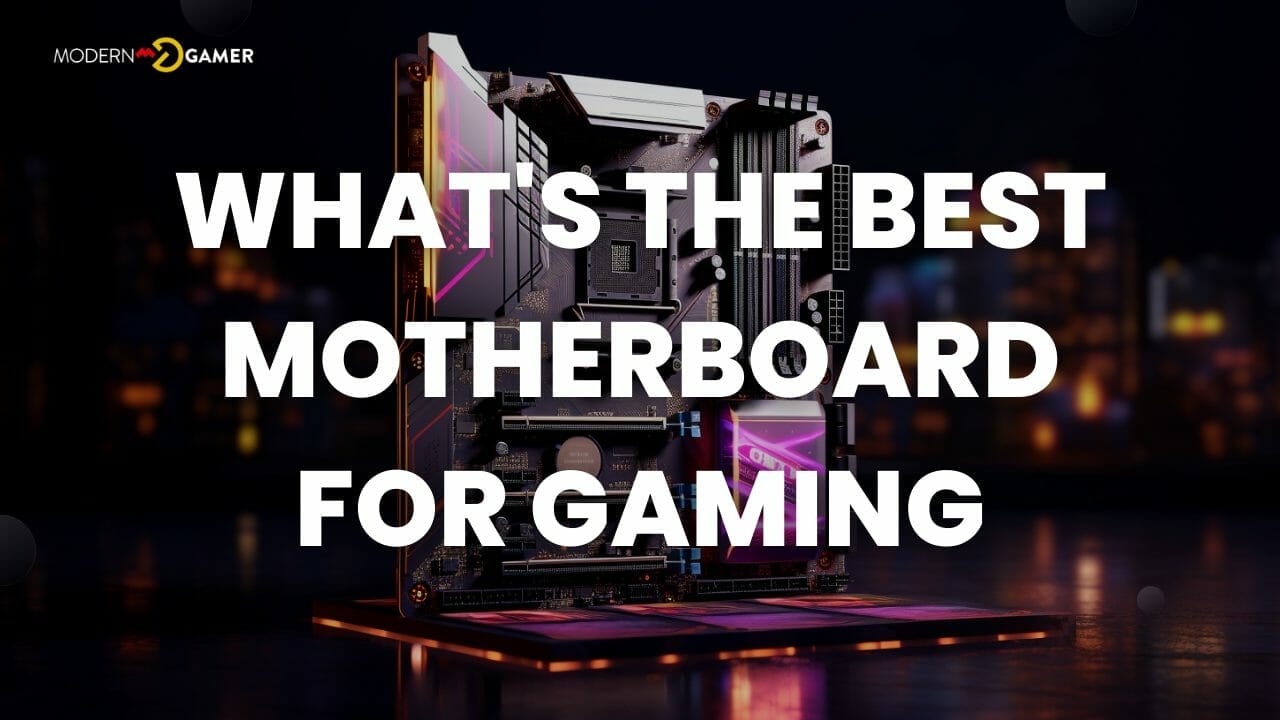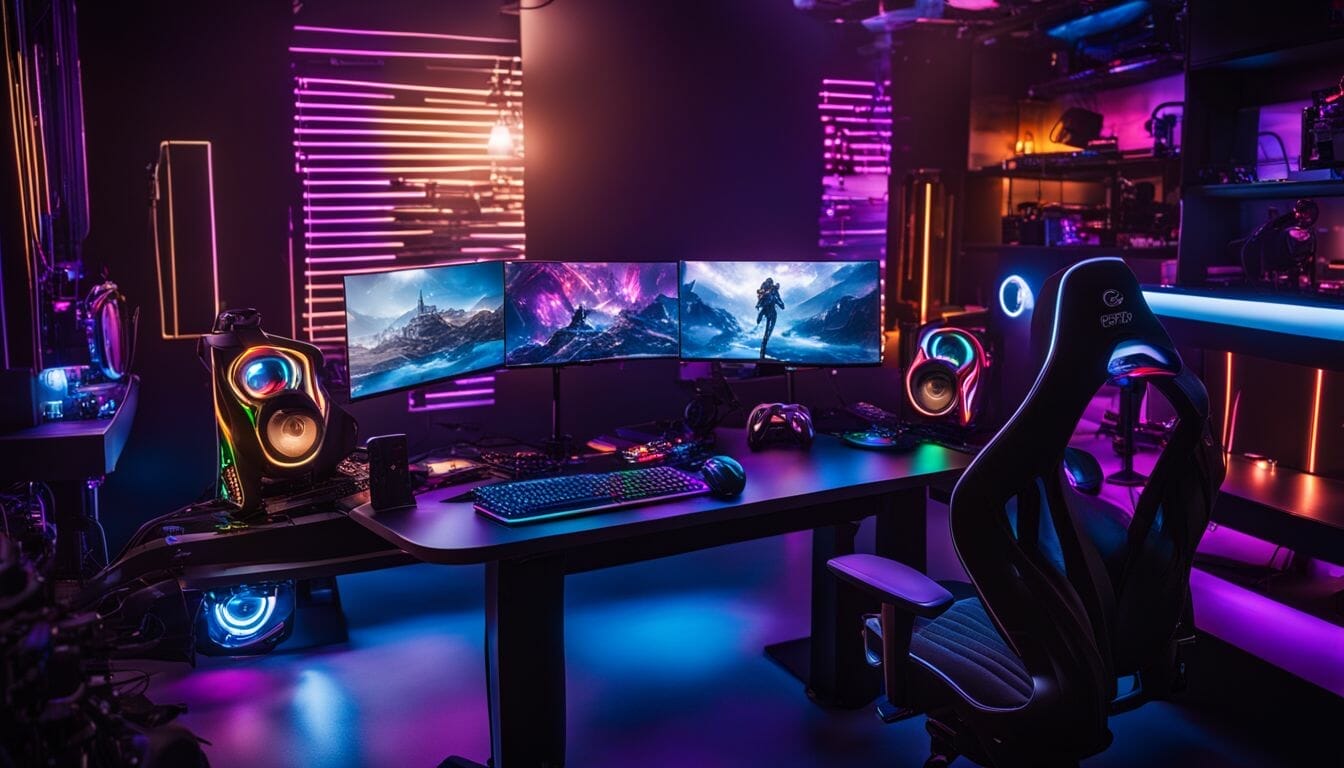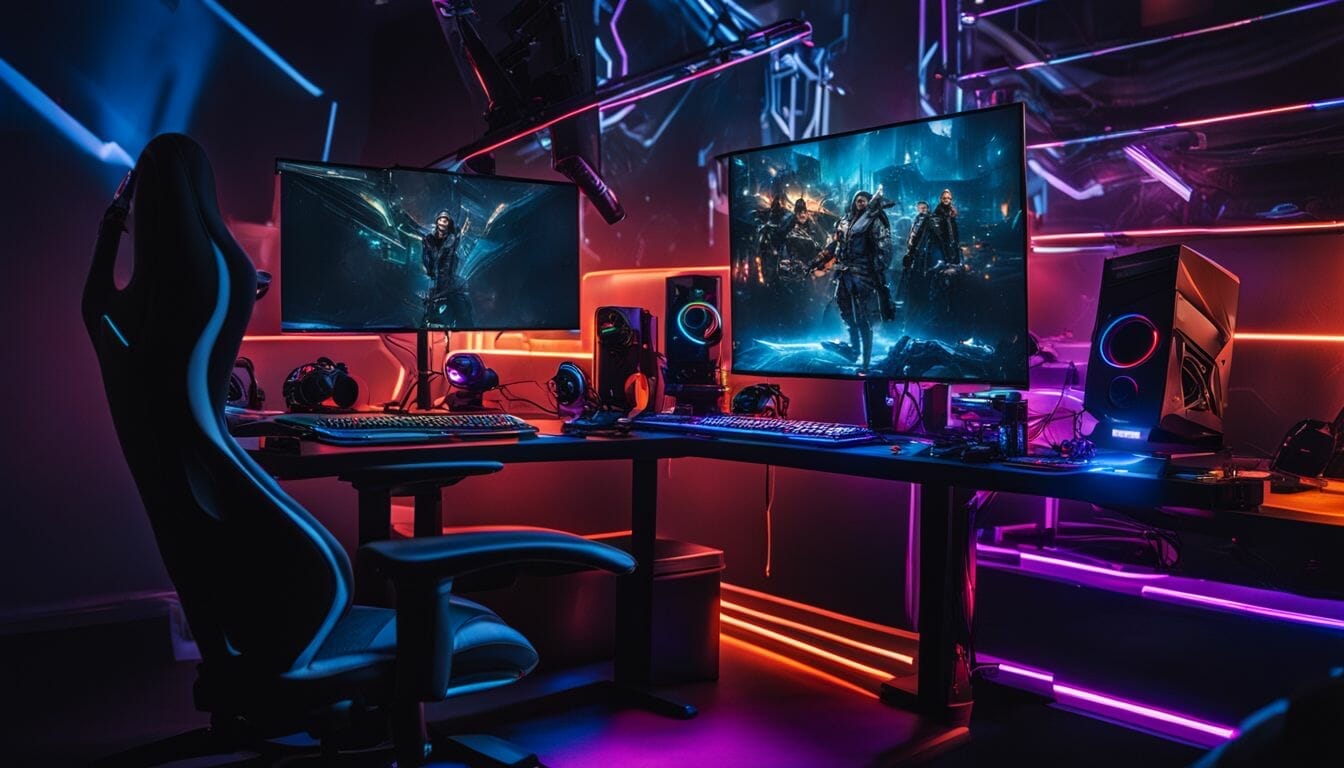Selecting the Best Motherboard for Gaming Performance

Selecting the ideal motherboard poses a challenge for PC gamers. We understand – based on our direct experience, the market is flooded with countless choices, making the hunt for the perfect fit akin to searching for a needle in a haystack.
But don’t worry! This article simplifies things by bringing you expert reviews of the best gaming motherboards in 2023. There’s something here to supercharge every gamer’s PC experience – read on to discover what it is!
Key Takeaways
- Asus ROG Maximus Z790 Hero and MSI Z790 Edge WiFi DDR4 are top choices for gaming motherboards with Intel processors. They offer power, speed, and high-speed data transfers.
- For AMD processors, the Asus ROG Crosshair X670E Hero and Gigabyte B650E Aorus Master are recommended. They provide enhanced performance, overclocking capabilities, and support for high-speed storage options.
- When choosing a gaming motherboard, consider factors such as socket type compatibility, connectivity options, size considerations, performance features, and price to performance ratio. These factors will help you find the best motherboard for your needs.
Best Gaming Motherboards for Intel

The Asus ROG Maximus Z790 Hero and the MSI Z790 Edge WiFi DDR4 are two top choices for Intel gaming motherboards with impressive performance and features.
Asus ROG Maximus Z790 Hero
We love the Asus ROG Maximus Z790 Hero for its power and speed. It has a strong 20-stage power solution. This keeps your games running smooth with no issues. It uses DDR5 memory which makes things move faster than in other boards.
You’ll see high-speed data transfers thanks to next-gen PCIe 5.0 connectivity. The built-in WiFi 6E means you won’t have any problems with your wireless connection either! Plus, it works well with Intel’s latest desktop processors making it perfect for all the new games coming out!
MSI Z790 Edge WiFi DDR4
The MSI Z790 Edge WiFi DDR4 is built for game lovers like us. It supports powerful Intel Core, Pentium, and Celeron processors from 13th and 12th generation. This motherboard makes use of LGA 1700 socket.
It doesn’t stop there. One cool thing about this board is its memory support. It can take DDR5 memory with speeds up to a whopping 7200+ MHz when you push it over the limit! Not just that, it even works well with the DDR4 standard RAM if that’s what you got.
This beast has PCIe Gen 5 slots too! You can add your favorite expansion cards to make your PC better. Plus, no more slow internet! With WiFi 6E technology on board, you get quick and trusty internet without wires.
MSI Z790 Edge WiFi DDR4 sure has all it takes to give you an edge in gaming!
MSI MAG Z790 Tomahawk WiFi DDR4
We suggest the MSI MAG Z790 Tomahawk WiFi DDR4 for gaming. It’s built for Intel 13th Gen Core processors. The cost is about $300, which is good for Raptor Lake-based systems. This board sits above the Pro range and below MPG and MEG boards.
Fast and clean wireless connections come from Wi-Fi 6E use. It also has a quick 2.5Gbps LAN for those who want wired internet links.
Best Gaming Motherboards for AMD

When it comes to gaming on an AMD platform, there are some top contenders for the best motherboard. Some of our favorites include the Asus ROG Crosshair X670E Hero, Gigabyte B650E Aorus Master, and MSI MAG B650 Tomahawk WiFi.
These motherboards offer excellent performance and features that are perfect for serious gamers.
Asus ROG Crosshair X670E Hero
The Asus ROG Crosshair X670E Hero is one of the best gaming motherboards for AMD processors. It is specifically designed to work with Ryzen 7000 series processors, providing enhanced performance for your gaming needs.
With its 18+2 power stages, this motherboard ensures a stable and reliable power supply to your components. It also offers multiple M.2 slots, allowing you to take advantage of high-speed storage options for faster loading times and smooth gameplay.
The ATX form factor makes it compatible with various PC cases, giving you flexibility in building your gaming rig. Keep in mind that the price of this motherboard is around $700, but if you’re looking for top-notch performance and features, it’s definitely worth considering.
Gigabyte B650E Aorus Master
The Gigabyte B650E Aorus Master is one of the best gaming motherboards for AMD. It is compatible with AMD Socket AM5 and Ryzen 7000 series processors, which means you can enjoy a powerful gaming experience.
This motherboard supports up to 128GB of DDR5-6666+(OC) memory, so you’ll have plenty of memory space for your games.
One standout feature of the Gigabyte B650E Aorus Master is its innovative thermal design. This design helps to keep your motherboard stable even during intense gaming sessions, ensuring that you don’t experience any performance issues or overheating problems.
Additionally, this motherboard offers a PCIe 5.0 M.2 interface, allowing you to take advantage of high-speed storage options for faster load times in your games.
If you’re looking for a gaming motherboard with great features and overclocking capabilities, the Gigabyte B650E Aorus Master is definitely worth considering. Its compatibility with AMD processors and impressive memory capacity make it a top choice for gamers who want high-performance hardware.
MSI MAG B650 Tomahawk WiFi
The MSI MAG B650 Tomahawk WiFi is one of the best gaming motherboards for AMD. It supports DDR5 memory and can overclock it to speeds of DDR5-6400+. With its ATX form factor and compact size measuring 305 × 244 mm, it fits well in most PC cases.
This motherboard includes three M.2 slots for 4.0 x4 SSDs, giving you high-speed storage options for your games and files. It also comes with USB 3.2 Gen 2 ports and supports HDMI/DP output, ensuring smooth gaming experiences.
Furthermore, the MSI MAG B650 Tomahawk WiFi features Wi-Fi 6E connectivity, providing fast and stable wireless connections while you play your favorite games online.
Factors to Consider When Choosing a Gaming Motherboard
When choosing a gaming motherboard, it’s important to consider factors such as socket type compatibility, connectivity options, size considerations, performance and features, as well as the price to performance ratio.
Don’t miss out on these essential details that can greatly impact your gaming experience!
Socket type compatibility
Choosing the right gaming motherboard is important for smooth performance. One key factor to consider is socket type compatibility. This refers to matching the CPU and motherboard sockets so they can communicate properly.
Different processors have different socket types, so you need to make sure the motherboard has the correct socket for your CPU. You can find this information in the CPU’s documentation or specifications.
It’s crucial to get this right because using an incompatible socket could lead to performance issues or even damage your components. So, when picking a gaming motherboard, always check that it has the proper socket for your processor.
Connectivity options
Connectivity options are an important consideration when choosing a gaming motherboard. These options determine how you can connect different devices and components to your motherboard, such as graphics cards, storage drives, and peripherals like keyboards and mice.
It’s crucial to have the right connectivity features for your needs.
When looking at connectivity options, one of the key aspects to consider is the form factor of the motherboard. Different form factors have different sizes and layouts, which affect the number and types of ports available.
For example, ATX motherboards typically have more expansion slots than smaller micro-ATX or mini-ITX boards.
Another important factor is compatibility with other components. You’ll want to make sure that the motherboard has enough RAM DIMM slots for your desired amount of memory. Additionally, having sufficient SATA ports ensures you can connect multiple storage drives like SSDs or HDDs without any issues.
Size considerations
The size of the motherboard is an important factor to consider when choosing a gaming motherboard. It determines the size of your PC build and affects how many components you can fit into it.
There are different form factors to choose from, such as ATX, micro ATX, and mini ITX. ATX motherboards are larger and offer more expansion slots and connectivity options. On the other hand, micro ATX and mini ITX motherboards are smaller and more compact.
So, depending on the size of your PC case and how much room you need for expansion cards like graphics cards or sound cards, you should choose a motherboard that fits your needs. Keep in mind that the number of RAM slots on a motherboard is also important because it determines how much memory you can have in your system for smooth gaming performance.
Performance and features
When choosing a gaming motherboard, it’s important to consider its performance and features. The motherboard’s chipset determines its compatibility with processors and other components.
Different chipsets offer different features, such as overclocking capabilities or support for higher RAM speeds. Additionally, consider the number of RAM and storage slots available on the motherboard, as this will determine the amount of memory and storage you can install.
Expansion slots also play a role in performance, allowing you to add additional components like graphics cards or sound cards. Take into account these factors to ensure your gaming motherboard has the right performance and features for your needs.
Price to performance ratio
The price to performance ratio is a critical factor when choosing a gaming motherboard. It helps us determine the value for our money and find an affordable option that maximizes performance.
By comparing different motherboards based on their cost efficiency, we can ensure we’re getting the best bang for our buck. Looking for an optimal price to performance ratio will help us strike a balance between the features we need and the budget we have, ultimately resulting in a cost-effective choice for our gaming setup.
Frequently Asked Questions About Gaming Motherboards
Have questions about gaming motherboards? We’ve got you covered. Read on to find answers to common queries and gain a better understanding of what makes a motherboard ideal for gaming.
How much RAM is needed for gaming?
The recommended amount of RAM for gaming is 16GB. This will provide a noticeable increase in performance compared to having only 8GB. You see, upcoming games are expected to have a normal RAM requirement ranging from 8GB to 16GB.
Gaming motherboards can typically support either 32GB or even 64GB of RAM, so you’ll have plenty of room for future upgrades if needed. Keep in mind that the amount of RAM needed for gaming depends on the specific workloads and tasks you’re performing.
Some high-end gaming applications may require at least 4GB of RAM, so it’s always good to have some extra memory on hand just in case!
Is DDR5 worth it?
DDR5 RAM offers improved performance and faster speeds compared to previous generations. It’s especially beneficial for users with memory-intensive workloads like gaming, video editing, and programming.
While DDR5 RAM may come with a higher price tag, it does make a noticeable difference in gaming, providing an enhanced experience. However, before deciding if DDR5 is worth it for your gaming setup, it’s important to assess your specific needs and evaluate the cost-benefit ratio.
What is the typical lifespan of a gaming motherboard?
The lifespan of a gaming motherboard can vary, but on average it typically lasts around 2-3 years if used properly. However, with proper care and maintenance, a PC motherboard can last anywhere from several months to several decades, with a common lifespan of 10-20 years.
So, it’s important to take good care of your gaming motherboard to ensure its longevity and optimal functionality.
Conclusion
In conclusion, when it comes to choosing the best gaming motherboard, there are several options to consider. For Intel processors, the Asus ROG Maximus Z790 Hero and MSI Z790 Edge WiFi DDR4 are top choices.
For AMD processors, the Asus ROG Crosshair X670E Hero and Gigabyte B650E Aorus Master are recommended. Factors like socket compatibility, connectivity options, size considerations, performance features, and price should also be taken into account when making a decision.
Ultimately, the best gaming motherboard will depend on your specific needs and budget.
FAQs
1. What factors should I consider when choosing a motherboard for gaming?
When choosing a motherboard for gaming, you should consider factors such as compatibility with your CPU and other components, the number of RAM slots and expansion slots available, and support for features like overclocking or multiple graphics cards.
2. Does the size of the motherboard matter for gaming?
Yes, the size of the motherboard does matter for gaming. Smaller motherboards like Mini-ITX may have fewer expansion slots and limited space for cooling solutions compared to larger ATX or EATX boards.
3. Can any motherboard support all types of CPUs?
No, not all motherboards can support all types of CPUs. Each CPU has specific socket requirements, so it’s important to choose a motherboard that is compatible with your chosen CPU.
4. Is it necessary to have multiple graphics card slots on a gaming motherboard?
Having multiple graphics card slots on a gaming motherboard is beneficial if you plan to use multiple GPUs in SLI or Crossfire configurations to enhance your gaming performance. However, it is not necessary for every gamer.
5. Do I need an expensive high-end motherboard for gaming?
You don’t necessarily need an expensive high-end motherboard for gaming unless you require advanced features like extreme overclocking or extensive connectivity options. Mid-range motherboards often offer sufficient performance and functionality at more affordable prices

